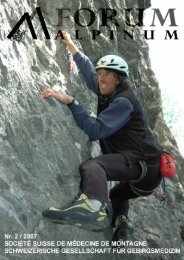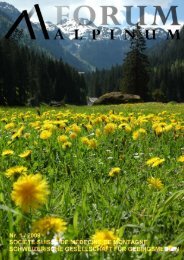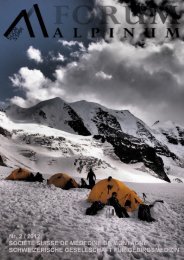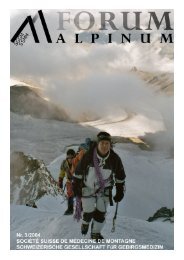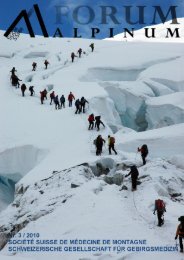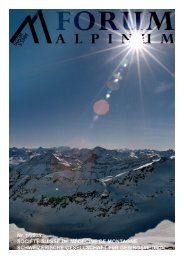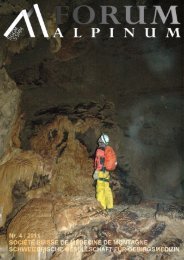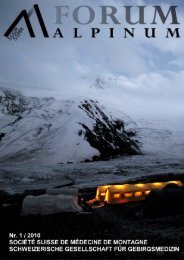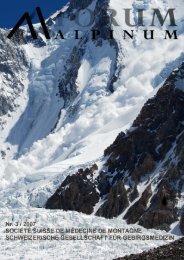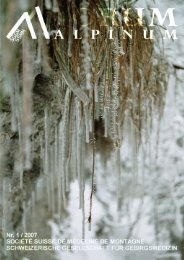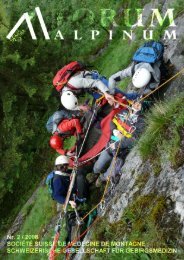abstracts 2010 - Schweizerische Gesellschaft für Gebirgsmedizin
abstracts 2010 - Schweizerische Gesellschaft für Gebirgsmedizin
abstracts 2010 - Schweizerische Gesellschaft für Gebirgsmedizin
Erfolgreiche ePaper selbst erstellen
Machen Sie aus Ihren PDF Publikationen ein blätterbares Flipbook mit unserer einzigartigen Google optimierten e-Paper Software.
assessment. The definitions of risk and benefit<br />
levels are given in an explanation of the chart.<br />
Finally a risk/benefit matrix with suggested<br />
actions can be used (figure 2). As with the<br />
US Coast Guard version, the avalanche rescue<br />
adaptation is intended as a tool for making quick,<br />
tactical decisions at the field commander level<br />
(Kristensen, 2004, 2007).<br />
Risk \ Benefit High<br />
Medium<br />
Low<br />
Low<br />
Acceptable, common risk reduction<br />
measures.<br />
Acceptable, common<br />
risk reduction<br />
Acceptable, common risk<br />
reduction measures.<br />
measures.<br />
Continuously monitoring of risk<br />
Continuously monitoring of<br />
factors<br />
Continuously monitoring risk factor<br />
of risk factors<br />
Moderate Acceptable, common risk reduction<br />
measures.<br />
Acceptable with all<br />
available consequence<br />
Not acceptable at present.<br />
Wait until risk factors<br />
reduction measures. change.<br />
Continuously monitoring of risk Continuous monitoring<br />
factors<br />
and rescue<br />
preparedness. Limit<br />
exposure in time<br />
Considerable Acceptable with all available<br />
consequence reduction measures.<br />
Not acceptable at<br />
present. Wait until risk<br />
Not acceptable<br />
Continuous monitoring and rescue<br />
preparedness. Limit exposure in<br />
time.<br />
factors change.<br />
High<br />
Not acceptable at present. Wait until<br />
risk factors change.<br />
Not acceptable<br />
Very high<br />
Not acceptable<br />
Figure 2. The risk/benefit matrix tried by the NRC-SAR.<br />
The mission risks and benefits are given by the score<br />
chart.<br />
2.1 Simulation/optimization approach<br />
The risk matrix approach has some inherent<br />
weaknesses (see discussion in section 3.1). A<br />
step further is to use simulation techniques for optimizing<br />
decisions under uncertainty. This is done<br />
by using simulation and statistical data in a numerical<br />
model that allows assessing the expected<br />
utility and risk/benefit ratio by considering key variables<br />
affecting both rescuers and the buried subject(s).<br />
The large number of input variables, their<br />
probability and the interaction between the input<br />
variables lead to a level of complexity which is<br />
handled by this decision support tool.<br />
The complexity of this problem reaches a<br />
level where an algebraic approach may not satisfy<br />
the requirements. Therefore a simulation based<br />
approach has been chosen, which allows incorporating<br />
a vast amount of variables from different<br />
fields of influence with various dependencies between<br />
the input variables.<br />
The aim of the numerical simulation is to<br />
quantify and balance the collective survival<br />
chances of the population of buried subjects and<br />
the collective risk for the rescue operation (human<br />
loss only).<br />
For each variable and event, likelihood<br />
and quantified influence to victim’s survival<br />
chances and / or rescuer’s risks are defined. Only<br />
variables which may be determined with an acceptable<br />
certainty are taken into account.<br />
The survival chances of the buried subjects<br />
are mainly influenced by factors from two<br />
fields:<br />
a) Survival chances within the debris.<br />
Characteristics of the buried subject, burial<br />
location, and mechanical stress to the buried<br />
subject during the motion phase of the avalanche.<br />
∗<br />
b) Burial duration.<br />
Detectability of the buried subject, burial<br />
depth, size of debris, number of buried subjects,<br />
availability, rescuer’s competence<br />
level, and accident site access parameters.<br />
The collective risk for the rescue crews is<br />
mainly influenced by:<br />
a) Rescuer’s related internal risks.<br />
Competence level, physical fitness, active<br />
and passive personal protection measures.<br />
b) Rescuer’s related external risks<br />
Duration and type of exposure to natural<br />
hazards, risks related to technical means of<br />
transport, risks related to uncertainty due to<br />
limited ability to evaluate terrain, weather,<br />
snow pack and other hazards.<br />
The operational application of the simulation<br />
is an ongoing effort. For this, the simulation<br />
should provide a user-friendly user interface. Data<br />
entry in dynamic forms ensures that there is no<br />
valuable time lost in cases where key variables<br />
indicate that the victim’s survival chances are high.<br />
The lower the survival chances and the smaller<br />
the decrease gradient of the survival chances, the<br />
more details need to be entered. Since the acceptable<br />
risk is low in such cases, the uncertainty<br />
should be rigorously reduced.<br />
The current concept of the simulation only<br />
shows the operator the collective survival chances<br />
and the collective risk of entered parameters.<br />
However, the concept could in a later state be expanded<br />
to a simulation which shows to the operator<br />
a proposal of the three simulated approaches<br />
with the highest scores for the risk / benefit comparison.<br />
∗ Survival chances of a buried subject are based on the Brugger/Falk<br />
(1994) survival curve and supplementary correction<br />
factors. New technologies like remote vital sign detection may<br />
reduce the uncertainty concerning survival chances.



